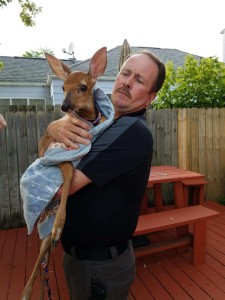 By Susan Bromley
By Susan Bromley
Staff Writer
Brandon Twp.- Does can leave their fawns unattended for several hours while they are off foraging.
Well-intentioned humans often mistake such baby deer as abandoned and remove them from the location their mother left them. But it was clear that a fawn seen wandering at about 6 p.m., June 19 along the edge of Bald Eagle Lake was motherless and in need of rescue, particularly after she ran toward M-15 and became stuck between two fences near Glass Road, across from Subway.
A resident called police for help, and Oakland County Sheriff’s Office Lt. Greg Glover responded to the scene. With the help of citizens, Glover got a dog leash around the fawn’s neck and freed her from the trap she found herself in, wrapping the wet and scared fawn in a blanket. They then placed the fawn in a dog crate, which Glover put in the back of his patrol car. “We get calls on occasion about fawns found, but they are usually stuck in a fence or something like that, or the people are looking for rescues to take baby animals,” said Glover.
“In this case, the mother was nowhere to be found. It would be unusual for them to be in that area because of the number of residents around.”
He suspected the fawn was dehydrated and recalled that a few days prior, deputies had been called to the area of M-15 and Glass Road after a vehicle struck a large doe. The deer was located behind Subway with a broken leg and was euthanized.
“I would be willing to bet this was her fawn,” said Glover, who took the baby to his residence, where the deer followed his sons around their garage while he made some calls and found a wildlife rehabilitator licensed by the Michigan Department of Natural Resources to take care of the animal.
Holly Vaughn, DNR wildlife communications coordinator, said licensed rehabilitators will care for wild animals until their injuries are healed, or if they are orphaned, until they are able to fend for themselves, at which time they are released, usually into the same area in which they were found.
Vaughn cautions however, that nine times out of ten, when a fawn or baby rabbits are found alone, their mothers are nearby and they should not be touched.
“Parents leave them alone for up to eight hours at a time as they feed and take care of their own needs,” she said. “The mother will leave her fawn or baby rabbits tucked in tall grass or even a yard and sometimes some other unlikely place.”
She further explained that fawns don’t have a scent and the mother can leave her baby without much fear of it being discovered by a predator. If a person discovers a fawn or nest of rabbits, it is best to leave it alone. Touching the animals will leave a human scent and make it more likely that a predator will find them. If there is concern that the animals have been abandoned or orphaned, a ring of flour can be left around the animal and later checked to see if it has been disturbed. A very thin fawn, or one that is bleating in a manner similar to a sheep might be clues they have been orphaned. When in doubt, call a wildlife rehabilitator to seek guidance on whether an animal may be in need of help. A full list of licensed wildlife rehabilitators can be found at www.michigandnr.com/dlr.
